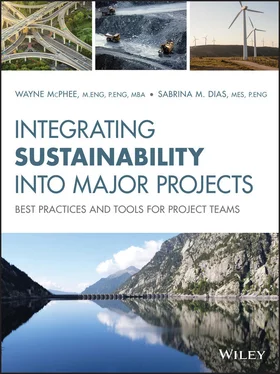We have based this book our own practical experiences, as well as drawing on the wisdom and experience from professionals we have had the privilege of working with on project teams. We hope this book will provide a solid foundation and starting point for individuals and project teams and look forward to hearing your experiences and insights that can help all of us develop better, more sustainable major projects.
1 1Turner, Lauren, “Two Ways Sustainability Drives Access to Capital, Network for Business Sustainability,” September 12, 2016, accessed at https://nbs.net/p/two-ways-sustainability-drives-access-to-capital-973e115d-0141-4251-8a05-5739d5fd9cb4on March 1, 2019.
2 2Wheeler D., Colbert, B., and Freeman, R.E., “Focusing on Value: Reconciling Corporate Social Responsibility, Sustainability and a Stakeholder Approach in a Network World,” Journal of General Management 28, no. 2 (Spring 2003).
3 3Kurucz, E.C., Wheeler, D., and Colbert, B.A., Reconstructing Value: Leadership Skills for a Sustainable World (Rotman-UTP Publishing, 2013).
4 4M.E. Porter and Kramer, M.R., “Creating Shared Value,” Harvard Business Review, January–February 2011.
5 5C.K. Prahalad and Ramaswamy, V., The Future of Competition: Co-Creating Unique Value with Customers (Harvard Business Press, 2004).
CHAPTER 2 Overview of Major Projects
Before we dive into discussing integrating sustainability into major projects, it is important to explore some of the concepts around major projects so that we establish a shared understanding and language for this book. This starts with a review of what makes a project “major” and how that creates unique challenges and opportunities for project managers and teams, especially related to sustainability concepts. The discussion will also consider different challenges for a broad range of major projects that include resource extraction, energy, industrial, infrastructure, or linear infrastructure, as well as projects that could have elements of more than one type of major project, like an energy facility that includes a transmission line, or a new mine with an access railroad and a new port facility.
The next step is to understand the key players on major projects. We will be discussing the project owner and overall project team, government employees, and local communities. It is important not only to discuss who is involved but how they interact with one another. Most project teams have a good understanding of the people and groups involved in the design and delivery of the project, and many understand financial players and government regulators. But they may not have as much experience considering local communities as key players and contributors to the success of a major project.
It is also important to consider how each of the key players perceives and interacts with the project by their sense of space (location of the project) and time (how long they will be engaged with the project), and their perception of risk and reward.
The typical timeline that a project takes to move from concept to construction and commissioning will be discussed with a focus on the three main parallel paths that include 1) design and delivery, 2) sustainability, and 3) financial management. Each of these three paths has hurdles that need to be crossed for the project to be successfully delivered. This requires project teams to understand the three paths and how everyone can contribute to the project's progress toward becoming reality.
This overview of the major projects includes some common management structures of major projects from EPCM (engineering, procurement, and construction management) to DBFOO (design-build-finance-own-operate), with a focus on how the choice of project structure can influence the team's ability to integrate sustainability into project management. Project structures that separate the organization's financial performance from the long-term efforts to maintain community support and manage social and environmental impacts can potentially create conflict between the key players on the project. These organizations should consider using strategies that help balance objectives and reduce the risk of conflict.
2.1 What Is a Major Project?
The discipline of project management includes a wide range of project types, from software system installation, to a house renovation, to the construction of a new mine or nuclear power plant. There is no good definition of what makes a project a “major” project. For the purposes of this book, a major project typically:
Involves the construction of a physical structure
Is large enough to require a separate team of specialists to deliver the project
Is managed and structured outside of an existing operation
Gets financing outside of the normal organizational cash flow
Is located in a new geography or involves an expansion of the footprint of an existing facility
Engages new stakeholders or impacts existing stakeholders in a new way
Smaller projects can also get significant benefits from improved sustainability management. The broad definition of major projects is provided to give some context to the discussion in the book, but the insights, models, and tools that we have provided can also be used on smaller projects. Smaller projects may not need all of tools but many of the concepts will still be useful for identifying project-specific challenges and opportunities, managing communications with the local community, and creating better projects.
2.2 Types of Major Projects
There are many types of major projects, from nuclear power plants to highways to mines, and all of these major projects have similar sustainability challenges and opportunities. When evaluating how to integrate sustainability into their specific project, teams should think more broadly about major projects rather than just looking at their own industry sector. Cross pollination of ideas across industries has helped to build the tools and processes collected in this book and will continue to allow improved sustainability of major projects across industries and geographies.
The main types of major projects are discussed below with a review of the unique challenges that each type of project can have for the team.
Infrastructure projects include a wide range of facilities that generally support a large number of local users and include:
Airports
Marine facilities
Landfills and waste disposal
Water and waste water treatment plants
Hospitals
Infrastructure projects are often developed as public projects that are managed by governments or government agencies but can also be privately built projects that make money from user fees or tolls. Or they can be developed as public-private partnerships (P3). Infrastructure projects have unique challenges, including managing multiple users of the facility and the potential for safety and security concerns associated with the public use of the facilities.
Sustainability can be a challenge for these projects because they will provide a public benefit for the public at large, and so project teams tend to assume that the broader and long-term benefits counterbalance the short-term construction pains. It is often assumed that public good will be sufficient to overcome the resistance of the people living closest to the facility. Developing strong sustainability programs for infrastructure can be important in avoiding a not-in-my-backyard (NIMBY) response from the local community.
Linear infrastructure projects are a specific type where the facility is built to connect locations together, including:
Читать дальше












